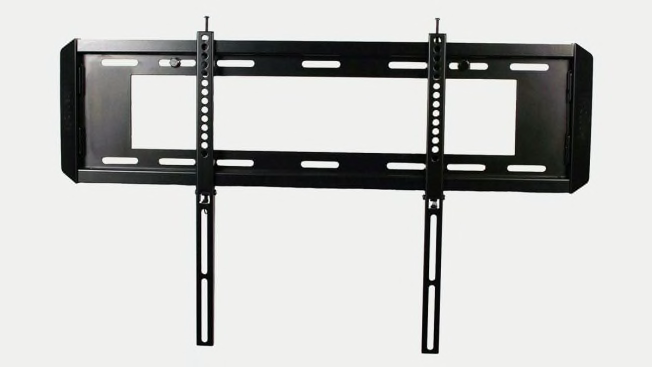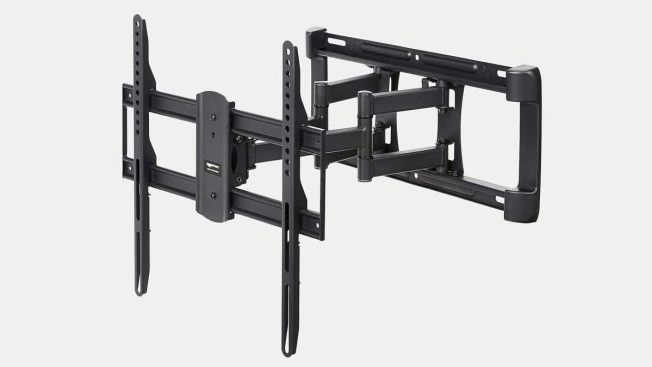Tv Mount-How to Choose the Best TV Mount
How to Choose the Best TV Mount
There are good reasons that more people are wall-mounting their new TVs these days. A wall-mounted television can save space and make a room look better. A TV that might seem too big if it’s sitting on a stand will be less imposing if you hang it on a wall.
Wall-mounting can also prevent dangerous TV tip-overs, which send hundreds of kids to the emergency room every year.
But you need to get the right mount for the TV, and for your room.
Check the Specs
Start off by making sure any TV mount you’re considering can handle the size and weight of your set. The maximum weight and screen-size specifications will be listed on the TV mount’s box and the company website. Just because two mounts can handle the same size television, don’t assume they are rated for their same weight—that differs by brand.
Next, consider the construction of the wall where you plan to hang your TV. Most TV mounts are compatible with traditional wood-stud framing and drywall, but you might need a special mount if you’re hanging your TV on other types of walls, such as plaster, concrete, or brick.
Get the Right Type of TV Mount
There are several types of mounts, including fixed, tilting or swiveling, and full-motion. One style isn’t better than another—it all depends on the layout of your room, where you plan to hang the TV, and where you’ll be sitting.
We wanted to see if certain types or individual TV mount models were easier to install and use. To find out, we built a wall just like the ones in many houses: drywall over 2x4 framing, with the centers of the studs 16 inches apart. Then we bought a bunch of wall mounts in various styles, in prices from $35 to $350, and installed them using the included hardware. For our test TV, we used a 55-inch LG model that weighed just over 40 pounds. As it turned out, all of the models worked well.
Here’s what you need to know to choose the right style of TV mount.

Fixed mounts, like the one shown above, don’t let you tilt or swivel your TV. They’re great choices if you mainly sit directly in front of your TV and have the space to keep the TV at an optimal position, angle, and height. (Some models have adjustable leveling screws to make sure the TV is perfectly level after it’s mounted.)
These mounts, including one we tried—the Kanto Fixed TV Wall Mount, $55, available at Best Buy and Office Depot—often don’t leave a lot of room between the TV and wall. Before you hang one, see if the TV has connections on the side of the set. Otherwise, connect the cables from your cable box, streaming player, or game console before the TV is mounted.

Photo: Sanus
Tilting mounts are better than fixed mounts choices if you’ll be viewing your TV from any sort of angle. A tilting mount lets you angle the TV downward if you’re hanging the set high on the wall. That can help maintain the best viewing angle when you’re seated, provided you’ll still be sitting directly in front of the TV, and can also let you adjust the angle to reduce any glare bouncing off the screen. We don’t recommend mounting a TV above a fireplace because heat and smoke can cause damage, but nonetheless, it’s a popular option where a tilting mount makes great sense.
If the TV will be both higher than your seating position and off at an angle, consider a mount that can both tilt and swivel, such as the Sanus Advanced Tilt 4D TV Wall Mount, $170, shown above, which is available at Amazon and Best Buy. Models vary in terms of how far they can swivel. Depending on the range of motion, tilting models generally stick out a bit farther from the wall than fixed mounts.

Photo: Amazon
Full-motion, or fully articulated, mounts, such as the Onn Full Motion TV Wall Mount, $45, from Walmart, the Best Buy Essentials Large Full Motion Wall Mount, $60, and the Amazon Basics Dual Arm Full Motion Articulating TV Mount, $48 (shown above, it was out of stock as of mid-March 2023) offer greater placement options because they can move in any direction, including forward toward the viewer.
We tried a few versions, and found that the Onn and Best Buy models provided the most distance from the wall when pulled out, enabling a wide degree of viewing angles. Because they can swivel from side-to-side as well as tilt up and down, such mounts are a good choice for a TV that will be mounted high in the corner of a room. A larger, heavier TV might require a full-motion mount with two arms instead of one. In general, these mounts require the TV to be farther from the wall for maximum swivel when extended, but many can be pushed back closer to the wall when they’re not in use.
In addition to those three types of mounts, you can find specialty versions designed for specific applications. For example, some let you mount your TV from a ceiling, while others might have two wall mounting plates for mounting the set in a corner. There are also mounts specifically designed for mounting a TV above a fireplace that allow the set to be lowered for viewing.
Once you have the right type in mind, how do you choose a specific TV wall mount?
In our testing, all the wall mounts performed about equally well. They were pretty easy to install, and they all held our test TV securely. There were some differences, sure, including how far articulation mounts could rotate. But as long as you buy a mount that’s compatible with your TV, it should work as advertised.
Installing a TV Mount
If you’re handy, it’s really not too hard to wall-mount a TV. (For details, see "How to Wall-Mount Your TV.") Many mounts come with a template you can use to position and drill the holes. It’s best to lag-bolt the mount to the vertical studs behind the wall, not the drywall itself, or into masonry, for the most secure installation. The installation will go more smoothly if you have a stud finder (for wood-framed walls), a level, a drill, properly sized drill bits for drilling pilot holes, and a socket set for installing the bolts into the studs or the anchors used with masonry. And as tempting as it may be to go it alone, placing the TV onto the wall should be a two-person job: Large TVs are tricky to align and secure without help.
However, not everyone is comfortable with tackling this as a DIY project. Instead, you can get your TV professionally mounted. Prices vary, depending on the type of mount and how complicated the installation will be. Best Buy, Target, and Walmart offer installation using either their own staff members or an outside company. Prices start at about $70 to $100 for a very basic installation, but installing a mount on surfaces other than drywall (including brick, stone, or plaster), or mounting the TV above a fireplace, will cost more.
One last note: Concealing wires and cables can keep everything looking neat and professional. Most retailers sell concealment kits, also called raceways, that let you hide and organize cables without cutting into the wall. Most of these kits have an adhesive backing, so they can stick to your wall without damaging it. Many can be painted to match your wall color.
-
Reliable Tilt TV Mount Company & Manufacturer, Factory Price & ServiceNewsJul.29,2025
-
Installing TV Wall Mount in Apartment for Secure and Sleek SetupNewsJul.29,2025
-
High-Quality Tilt TV Mount Exporters for Secure InstallationNewsJul.29,2025
-
Professional Tilt TV Mount Company & Manufacturer, Competitive PricelistNewsJul.28,2025
-
Top Tilt TV Mount Exporters: Quality Manufacturer & Competitive PricingNewsJul.28,2025
-
Premium Tilt TV Mount Exporters & Manufacturers - Competitive PricesNewsJul.27,2025

